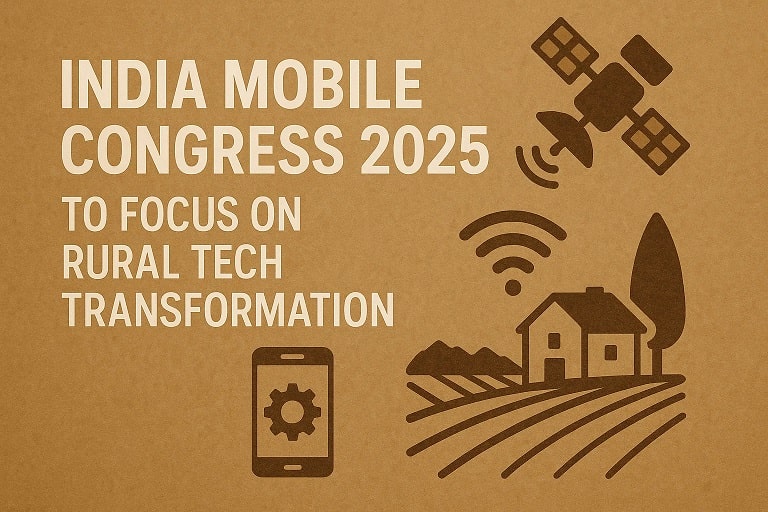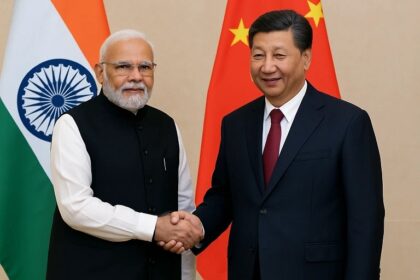India Mobile Congress 2025 to Focus on Rural Tech Transformation: Bridging the Digital Divide
The 9th edition of the India Mobile Congress (IMC) 2025, scheduled for October 8-11, 2025, at Yashobhoomi, New Delhi, will prioritize rural tech transformation as a key pillar of its theme, “Innovate to Transform.” Announced by Union Minister for Communications Jyotiraditya Scindia at MWC Barcelona on March 3, 2025, IMC 2025 aims to showcase technologies like 5G, 6G, AI, IoT, satellite communications, and quantum computing to bridge India’s urban-rural digital divide. Organized by the Department of Telecommunications (DoT) and the Cellular Operators Association of India (COAI), the event expects over 100,000 attendees, 1,000 exhibitors, and participation from 120+ countries. With a focus on digital inclusion, IMC 2025 will highlight innovations to empower rural communities, aligning with Prime Minister Narendra Modi’s vision of a Viksit Bharat by 2047. This article explores the drivers behind this focus, historical context, future projections, and impacts, with emphasis on Tamil Nadu’s role in rural tech adoption.
Why Rural Tech Transformation Matters
India’s rural areas, home to 65% of its 1.4 billion population (approximately 910 million people), face significant connectivity gaps, with only 35% of rural households having internet access compared to 70% in urban areas (2024 TRAI data). Rural tech transformation through 5G, satellite broadband, and AI-driven solutions can enhance agriculture, education, healthcare, and financial inclusion, boosting rural GDP by an estimated ₹2.5 lakh crore by 2030. Tamil Nadu, with its robust digital infrastructure and rural initiatives like BharatNet, is poised to lead in deploying these technologies in its southern districts.
Latest Developments Driving Rural Tech Focus
IMC 2025’s emphasis on rural tech transformation responds to India’s digital inclusion goals and global tech trends. Key developments include:
- Theme and Vision: The “Innovate to Transform” theme underscores rural connectivity as a catalyst for socio-economic progress. Scindia highlighted India’s DSS capabilities (Designing, Solving, Scaling in India) to deliver affordable broadband and AI solutions to rural areas.
- Technological Showcase: IMC 2025 will feature over 1,000 use cases, including 5G for smart agriculture, satellite-based broadband (e.g., Jio Space Fiber at 1 Gbps), and AI-driven education platforms for rural schools, as demonstrated at IMC 2024.
- Policy Support: The DoT’s BharatNet Phase III, launched in 2024, aims to connect 6.4 lakh villages with high-speed internet by 2026, with Tamil Nadu allocating ₹1,500 crore for rural fiber deployment. The 2025-26 Budget prioritizes ₹10,000 crore for rural 5G expansion.
- Startup Ecosystem: The IMC Aspire program will host 1,000+ startups and 300+ investors, focusing on rural tech solutions like IoT for farming and drone-based disaster management, with Tamil Nadu’s startups contributing significantly.
- Global Context: US tariffs (50% on Indian imports, August 2025) push India to bolster domestic tech ecosystems, with rural connectivity reducing reliance on urban markets. IMC 2025 will attract global players like GSMA to collaborate on rural solutions.
Tamil Nadu’s Role
Tamil Nadu, with 37% of its 80 million population in rural areas, is a leader in digital infrastructure. Chennai’s IT ecosystem and Coimbatore’s startup hubs support rural tech innovation, while initiatives like TNeGA (Tamil Nadu e-Governance Agency) drive digital literacy in villages. The state’s 5G testbeds and BharatNet rollout enhance rural connectivity, making it a model for IMC 2025’s rural focus.
Historical Context of Rural Tech in India
India’s efforts to bridge the digital divide have evolved over decades, with mixed success due to infrastructure and literacy challenges:
- 2000s: The National e-Governance Plan (NeGP) introduced Common Service Centres (CSCs), connecting 1 lakh villages by 2010. Tamil Nadu pioneered CSCs in Madurai and Salem.
- 2015: Digital India launched BharatNet to fiber-connect 2.5 lakh gram panchayats, but only 1.2 lakh were connected by 2020 due to funding delays.
- 2020-2024: 5G rollout began, with Jio and Airtel covering 80% of urban areas but only 20% of rural areas by 2024. IMC 2022-2024 showcased rural 5G use cases, like Jio’s AI-based multi-language education system.
- 2024: IMC 2024, with 175,000 attendees and 900 startups, highlighted satellite broadband (e.g., Eutelsat OneWeb) and AI for rural education, setting the stage for 2025’s rural focus.
Tamil Nadu’s early adoption of CSCs and 5G testbeds positions it as a key player in scaling rural tech solutions.
Future Scopes and Projections
IMC 2025 aims to showcase over 1,000 rural-focused tech use cases, targeting a 50% rural internet penetration rate by 2027. Projections include:
- 5G and 6G: Rural 5G coverage is expected to reach 40% by 2027, with 6G pilots by 2030, enabling precision agriculture and telemedicine. Tamil Nadu’s 5G testbeds will drive R&D.
- Satellite Broadband: The satellite internet market, led by Jio Space Fiber and Starlink, is projected to grow six-fold to 2 million users by 2026, with 70% in rural areas.
- AI and IoT: AI-driven platforms for crop monitoring and multilingual education could benefit 10 million rural farmers and students by 2030, with Tamil Nadu’s startups developing IoT sensors.
- Economic Impact: Rural tech adoption could add ₹2.5 lakh crore to GDP by 2030, with Tamil Nadu contributing ₹30,000 crore through agriculture and education.
Long-Term Strategic Outlook
By 2035, India aims to achieve 80% rural internet penetration, with IMC fostering:
- Digital Inclusion: BharatNet and satellite broadband will connect 90% of villages, with Tamil Nadu targeting 100% coverage in its 12,525 gram panchayats.
- Skilling: IMC’s workshops will train 1 million rural youth in digital skills by 2030, with Tamil Nadu’s ITIs leading.
- Sustainability: Green tech solutions, like solar-powered 5G towers, will reduce rural carbon footprints by 15%.
- Challenges: Low digital literacy (30% in rural Tamil Nadu), high infrastructure costs (₹50,000 crore for BharatNet), and US tariff impacts on tech exports could hinder progress.
Impacts on the Indian Economy and Stakeholders
IMC 2025’s rural tech focus will drive economic and social benefits, with Tamil Nadu as a key beneficiary.
Sector-Wise Impacts
Agriculture
- Impact: 5G-enabled IoT sensors and drones for precision farming can boost yields by 20%, benefiting Tamil Nadu’s 50 lakh farmers in districts like Thanjavur.
- Economic Contribution: Rural agriculture could add ₹1 lakh crore to GDP, with Tamil Nadu contributing 10% via tech adoption.
- Business Opportunities: Agri-tech startups in Coimbatore will develop IoT and drone solutions, supported by IMC’s Aspire program.
Education
- Impact: AI-based multilingual platforms, like Jio’s system, will reach 5 million rural students, with Tamil Nadu’s rural schools adopting e-learning via BharatNet.
- Economic Contribution: Improved literacy could add ₹50,000 crore to GDP, with Tamil Nadu gaining 15% through education hubs.
- Business Opportunities: Edtech firms in Chennai will scale rural content delivery.
Healthcare
- Impact: 5G telemedicine and AI diagnostics will serve 10 million rural patients by 2030, with Tamil Nadu’s rural health centers in Madurai benefiting.
- Economic Contribution: Healthcare savings of ₹20,000 crore, with Tamil Nadu contributing 12%.
- Business Opportunities: Medtech startups will partner with IMC exhibitors for rural solutions.
Financial Inclusion
- Impact: UPI and 5G-enabled banking will reach 100 million rural users, with Tamil Nadu’s CSCs facilitating transactions.
- Economic Contribution: Financial inclusion could add ₹30,000 crore to GDP, with Tamil Nadu contributing 10%.
- Business Opportunities: Fintech firms in Chennai will develop rural banking apps.
Rural Tech Snapshot (IMC 2025 Focus)
Technology | Rural Application | Tamil Nadu Impact |
|---|---|---|
5G/6G | Smart agriculture, telemedicine | Thanjavur farmers, Madurai hospitals |
Satellite Broadband | High-speed internet in remote areas | Salem, Coimbatore connectivity |
AI/IoT | Crop monitoring, e-learning | Coimbatore startups, rural schools |
Drones | Disaster management, agri-spraying | Thanjavur precision farming |
This table highlights IMC 2025’s rural tech applications and Tamil Nadu’s role.
Frequently Asked Questions (FAQs)
What is the focus of IMC 2025?
IMC 2025, under the theme “Innovate to Transform,” prioritizes rural tech transformation through 5G, AI, IoT, and satellite broadband to bridge the digital divide.
How will rural areas benefit?
Technologies like 5G, satellite internet, and AI will enhance agriculture, education, healthcare, and financial inclusion, adding ₹2.5 lakh crore to GDP by 2030.
What is Tamil Nadu’s role?
Tamil Nadu’s digital infrastructure, startups, and BharatNet rollout support rural connectivity and innovation, contributing ₹30,000 crore to GDP.
What technologies will be showcased?
IMC 2025 will feature 1,000+ use cases in 5G, 6G, AI, IoT, satellite communications, and quantum computing, with a focus on rural applications.
What challenges could arise?
Low digital literacy (30% in rural areas), high infrastructure costs, and US tariffs on tech exports could delay rural tech adoption.












